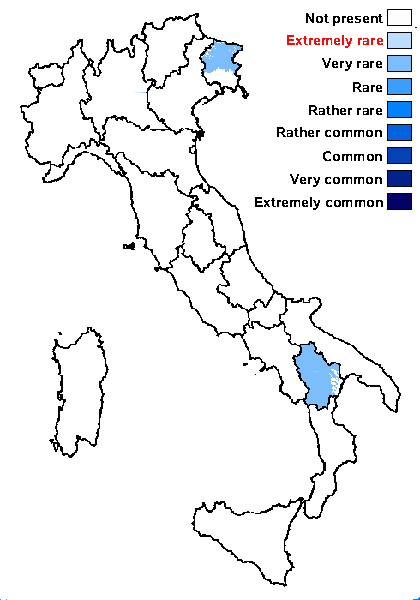Sarcogyne nivea Kremp.
Denkschr. kgl. bayer. bot. Ges., Abt. 2, 4: 212, 1861
Synonyms:
Distribution: N - Frl (Knudsen & al. 2023). S - Bas (Knudsen & al. 2023).
Description: Thallus crustose, thinly episubstratic, chalky white to pale brown, continuous to usually finely rimose, ecorticate-farinose, consisting of gelatinized hyphae with scattered algae covering the substrate. Apothecia lecideine, irregular in outline, 0.3-0.8(-1) mm across, with a dark brown to black (brown-red when moist), rarely bluish-pruinose, mostly flat disc, and a thin, usually persistent proper margin. Proper exciple (50-)100-120 μm wide, subparaplectenchymatous, of radiating hyphae with swollen and dark brown tips, the rim dark brown, the inner part colourless; epithecium brown; hymenium colourless, 80-110 µm high, the hymenial gel hemiamyloid, I+ light blue, greenish to red; paraphyses coherent, simple to sparingly branched, regularly septate; hypothecium colourless. Asci 80-100-spored, cylindrical-clavate, strongly thickened at apex, the apical dome I-, the outer coat K/I+ blue. Ascospores 1-celled, hyaline, subglobose to broadly ellipsoid, 3-5 x (1-)2-3 μm. Photobiont chlorococcoid. Spot tests: thallus K-, C-, KC-, P-, UV-. Chemistry: without lichen substances.Note: on limestone at low elevations; rare in Europe (W-Alps, Pyrenees, Bavaria, Czech Republic), but perhaps not recognised or overlooked.
Growth form: Crustose
Substrata: rocks
Photobiont: green algae other than Trentepohlia
Reproductive strategy: mainly sexual
Pioneer species
Commonnes-rarity: (info)
Alpine belt: absent
Subalpine belt: absent
Oromediterranean belt: absent
Montane belt: very rare
Submediterranean belt: very rare
Padanian area: absent
Humid submediterranean belt: very rare
Humid mediterranean belt: absent
Dry mediterranean belt: absent

Predictive model
Herbarium samples
Growth form: Crustose
Substrata: rocks
Photobiont: green algae other than Trentepohlia
Reproductive strategy: mainly sexual
Pioneer species
Commonnes-rarity: (info)
Alpine belt: absent
Subalpine belt: absent
Oromediterranean belt: absent
Montane belt: very rare
Submediterranean belt: very rare
Padanian area: absent
Humid submediterranean belt: very rare
Humid mediterranean belt: absent
Dry mediterranean belt: absent

Predictive model
| Herbarium samples |
 Index Fungorum
Index Fungorum
 GBIF
GBIF

